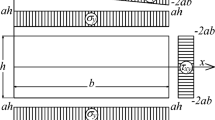Abstract
The availability of accurate methods to mathematically model and predict the behavior of viscoelastic structures under mechanical, thermal and other loads remains a critical issue in different fields ranging from construction engineering to aerospace. Methods to calculate elastic structures are well developed; however, considering that viscoelastic properties require significant effort, we have developed and tested a new analytical method to solve boundary problems of isotropic linearly viscoelastic bodies. According to the proposed algorithm, to find the solution for a linear viscoelasticity boundary problem, we must replace the elastic constants with some functions of time and then numerically or analytically calculate the stress–strain state of the structure at any moment of its loading history. As a result of the theoretical justification of the proposed method, carried out in three independent ways, identical expressions of effective modules are obtained. The obtained results, as well as testing on solutions to several problems, allow us to conclude that the new analytical method is applicable to the calculation of the stress–strain state of viscoelastic bodies.















Similar content being viewed by others
References
Lakes, R.: Viscoelastic Materials. Cambridge University Press, New York (2009)
Zhu, Z., Jiang, C., Jiang, H.: Visco-hyperelastic model of brain tissue incorporating both tension/compression asymmetry and volume compressibility. Acta Mech. (2019). https://doi.org/10.1007/s00707-019-02383-1
Pavlov, M.S., Ponomarev, S.A., Maritsky, N.N.: Mathematical model of composite fibre-glass aramide-wired cord rheological properties. AIP Conf. Proc. (2016). https://doi.org/10.1063/1.4964582
Tang, Y., Li, T., Ma, X.: Creep and recovery behavior analysis of space mesh structures. Acta Astronaut. (2016). https://doi.org/10.1016/j.actaastro.2016.08.003
Kwok, K., Pellegrino, S.: Micromechanics models for viscoelastic plain-weave composite tape springs. AIAA J. (2017). https://doi.org/10.2514/1.J055041
Maxwell, J.C.L.: On the dynamical theory of gases. Philos. Trans. (1867). https://doi.org/10.1098/rstl.1867.0004
Boltzman, L.: Zur Theorie der Elastischen Nachwirkung. Wiener Berichte. (1874). https://doi.org/10.1098/rstl.1867.0004
Volterra, V.: Lecons sur les fonctions de lignes. Gautierr Villars, Paris (1912)
Volterra, V.: Theory of Functionals and of Integral and Integrodifferential Equations. Blackie & Son Limited, London-Glasgow (1930)
Reddy, J.N.: An Introduction to Continuum Mechanics. Cambridge University Press, New York (2008)
Pipkin, A.C.: Lectures of Viscoelasticity Theory. Springer Verlag, New York (1986)
Flugge, W.: Viscoelasticity. Blaisdell Press, New York (1967)
Cristensen R. M.: Theory of Viscoelasticity: An Introduction Academic, New York (1980)
Taylor, R.L., Pister, K.S., Goudreas, G.L.: Thermochemical analysis of viscoelastic solids. Int. J. Numer. Methods Eng. (1970). https://doi.org/10.1002/nme.1620020106
Simo, J.C.: On fully three-dimensional finite strain viscoelastic damage model: formulation and computational aspects. Comput. Methods Appl. Mech. Eng. (1987). https://doi.org/10.1016/0045-7825(87)90107-1
Ataoglu, S.: A two dimensional mixed boundary—value problems in a viscoelastic medium. Struct. Eng. Mech. (2009). https://doi.org/10.12989/sem.2009.32.3.407
Chazal, C., Pitti, R.M.: Integral approach for time dependent materials finite element method. J. Theor. Appl. Mech. 49(4), 1029–1048 (2011)
Janovsky, V., Shaw, S., Wardy, M.K., Whiteman, J.R.: Numerical methods for treating problems of viscoelastic isotropic solid deformation. J. Comput. Appl. Math. (1995). https://doi.org/10.1016/0377-0427(95)00059-3
Lahellec, N.: Effective behavior of linear viscoelastic composites: a time integration approach. Int. J. Solids Struct. (2007). https://doi.org/10.1016/j.ijsolstr.2006.04.038
Wang, H.N., Nie, G.H.: Analytical expressions for stress and displacement fields in viscoelastic axisymmetric plaue problem involving time—dependent boundary regions. Acta Mech. 210(3), 315–330 (2010)
Matveenko, V.P., Smetannikov, OYu., Trufanov, N.A., Shardakov, I.N.: Constitutive relations for viscoelastic materials under thermorelaxation transition. Acta Mech. (2015). https://doi.org/10.1007/s00707-015-1313-7
Schapery, R.A.: Analysis of viscoelastic composite materials. J. Compos. Mater. (1967). https://doi.org/10.1177/002199836700100302
Haj-Ali, R., Muliana, A.: Numerical finite element formulation of the schapery non-linear viscoelastic material model. Int. J. Numer. Methods Eng. (2004). https://doi.org/10.1002/nme.861
Tsukrov, I., Eroshkin, O., Pail, W., Celikkol, B.: Numerical modeling of nonlinear elastic components of mooring systems. IEEE J. Ocean Eng. (2005). https://doi.org/10.1109/JOE.2004.841396
Pavlov, S.M., Svetashkov, A.A.: Iteration method for solving linear viscoelasticity problems. Russ. Phys. J. (1993). https://doi.org/10.1007/bf00570749
Svetashkov, A., Kupriyanov, N., Manabaev, K.: Modification of the iterative method for solving linear viscoelasticity boundary value problems and its implementation by finite element method. Acta Mech. (2018). https://doi.org/10.1007/s00707-018-2129-z
Carini, A., Gelfi, P., Marchina, E.: An energetic formulation for the linear viscoelastic problem. Part I: theoretical results and first calculations. Int. J. Numer. Methods Eng. 38(1), 37–62 (1995)
Matveenko, V., Trufanov, N.: Multi-operator boundary value problems of viscoelasticity of piecewise—homogeneous bodies. J. Eng. Math. (2011). https://doi.org/10.1007/s10665-011-9496-y
Efimov, A., Maliy, V.: Metod analiticheskogo prodolgeniya v zadachah lineynoy vyazkouprugosti stareyushih materialov. Izvestiya AN SSSR. Mehanika tverdogo tela 1, 5–13 (1974). (In Russian)
Matveenko, V., Troyanovsky, I., Caplina, G.: Postroenie resheniy zadach teorii uprugosti v vide ryadov po stepeni uprugih postoyannih I ih prilogeniya k vyazkouprugosti. Prikladnaya matematika i mehanika 60(4), 651–659 (1996). (In Russian)
Gurtin, M.E., Sternberg, E.: On the linear theory of viscoelasticity. Mech. Anal. 11(1), 291–356 (1962)
Ciarlet, P.G.: Mathematical Elasticity. Vol. 1: Three-Dimensional Elasticity. North-Holland. Amsterdam, New York, Oxford, Tokyo (1988)
Svetashkov, A.A.: Time-effective moduli of a linear viscoelastic body. Mech. Compos. Mater. (2000). https://doi.org/10.1007/bf02681774
Love, A.E.H.: A Treatise on the Mathematical Theory of Elasticity. University Press, Cambridge (1935)
Timoshenko, S.P., Goodier, J.N.: Theory of Elasticity 3rd ed. McGraw-Hill, New York (1970)
Rabotnov, YuN: Polzuchest elementov konstrukciy. Nauka, Moskow (1966). (In Russian)
Acknowledgements
This research was supported by Tomsk Polytechnic University CEP Grant Number DRIaP_75/2019.
Author information
Authors and Affiliations
Corresponding author
Additional information
Publisher's Note
Springer Nature remains neutral with regard to jurisdictional claims in published maps and institutional affiliations.
Rights and permissions
About this article
Cite this article
Svetashkov, A.A., Kupriyanov, N.A., Pavlov, M.S. et al. Variable separation method for solving boundary value problems of isotropic linearly viscoelastic bodies. Acta Mech 231, 3583–3606 (2020). https://doi.org/10.1007/s00707-020-02698-4
Received:
Revised:
Published:
Issue Date:
DOI: https://doi.org/10.1007/s00707-020-02698-4




